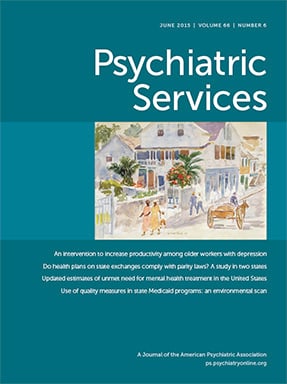Life Changes Among Homeless Persons With Mental Illness: A Longitudinal Study of Housing First and Usual Treatment
Abstract
Objective:
Methods:
Results:
Conclusions:
At Home/Chez Soi
Methods
Sample
Interviews
Data Coding and Analysis
Results
Differences in Changes Between Groups
| Variable | N | % |
|---|---|---|
| Need level | ||
| High | 92 | 44 |
| Moderate | 119 | 56 |
| Gender | ||
| Male | 132 | 63 |
| Female | 74 | 35 |
| Other | 5 | 2 |
| Aboriginal (First Nations, Metis, Inuit) | 49 | 23 |
| Ethnoracial minority group | 49 | 23 |
| Employment | ||
| Unemployed | 198 | 94 |
| Employed, volunteer, or in school | 13 | 6 |
| Education | ||
| Less than high school graduate | 119 | 56 |
| High school graduate | 34 | 16 |
| More than high school graduate | 58 | 28 |
| Marital status | ||
| Single, never married | 140 | 67 |
| Separated, divorced, or widowed | 68 | 32 |
| Married or cohabiting | 3 | 1 |
| Disorder | ||
| Major depressive episode | 111 | 53 |
| Manic or hypomanic episode | 34 | 16 |
| Posttraumatic stress disorder | 58 | 28 |
| Panic disorder | 53 | 25 |
| Mood disorder with psychotic features | 48 | 23 |
| Psychotic disorder | 67 | 32 |
| Alcohol dependence | 72 | 34 |
| Substance dependence | 106 | 50 |
| Alcohol abuse | 40 | 19 |
| Substance abuse | 56 | 27 |
| Age (M±SD) | 41.3±11.2 | |
| Last month’s income (M±SD Canadian$) | 781.0±839.7 | |
| Lifetime months of homelessness (M±SD) | 68.0±102.7 | |
| N of children under 18 (M±SD) | 1.0±6.7 |
| Site | Housing First (N=119) | Treatment as usual (N=78) | ||||||||||
|---|---|---|---|---|---|---|---|---|---|---|---|---|
| Positive | Mixed-neutral | Negative | Positive | Mixed-neutral | Negative | |||||||
| N | % | N | % | N | % | N | % | N | % | N | % | |
| Moncton | 6 | 75 | 2 | 25 | 0 | — | 1 | 13 | 3 | 37 | 4 | 50 |
| Montreal | 19 | 70 | 2 | 7 | 6 | 23 | 5 | 28 | 1 | 5 | 12 | 67 |
| Toronto | 20 | 65 | 8 | 26 | 3 | 9 | 7 | 37 | 5 | 26 | 7 | 37 |
| Winnipeg | 12 | 48 | 12 | 48 | 1 | 4 | 6 | 33 | 9 | 50 | 3 | 27 |
| Vancouver | 15 | 54 | 13 | 46 | 0 | — | 3 | 20 | 10 | 67 | 2 | 13 |
| Total | 72 | 61 | 37 | 31 | 10 | 8 | 22 | 28 | 28 | 36 | 28 | 36 |
Factors Related to Various Changes
Discussion
Conclusions
Acknowledgments
Supplementary Material
- View/Download
- 144.53 KB
References
Information & Authors
Information
Published In

Cover: Afternoon, Nassau, by Gifford Reynolds Beal, 1925. Watercolor on paper, 33.97 × 49.53 cm. Collection, Albright-Knox Art Gallery, Buffalo, New York. Gift of Mrs. Howell H. Howard to Room of Contemporary Art, 1963. Albright-Knox Art Gallery/Art Resource, New York City.
History
Authors
Funding Information
Metrics & Citations
Metrics
Citations
Export Citations
If you have the appropriate software installed, you can download article citation data to the citation manager of your choice. Simply select your manager software from the list below and click Download.
For more information or tips please see 'Downloading to a citation manager' in the Help menu.
View Options
View options
PDF/EPUB
View PDF/EPUBLogin options
Already a subscriber? Access your subscription through your login credentials or your institution for full access to this article.
Personal login Institutional Login Open Athens loginNot a subscriber?
PsychiatryOnline subscription options offer access to the DSM-5-TR® library, books, journals, CME, and patient resources. This all-in-one virtual library provides psychiatrists and mental health professionals with key resources for diagnosis, treatment, research, and professional development.
Need more help? PsychiatryOnline Customer Service may be reached by emailing [email protected] or by calling 800-368-5777 (in the U.S.) or 703-907-7322 (outside the U.S.).
